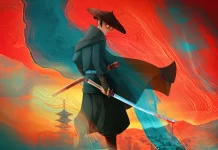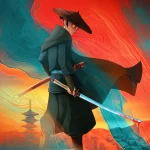The final season of Game of Thrones arrives April 14th. Before then, prepare by rewatching the first seven seasons.
You’ve been watching them, all of them, all of their lives, with a thousand eyes and one. Now you come to us at last, though the hour is late.
You can catch up with recaps of seasons one, two and three. And now, your watch continues with season four.
Novices beware: This article is dark and full of spoilers.
How should I rewatch Game of Thrones season four?
Concentrate on the installments that are central to the famously complicated plot and provide all the feels. Here are four must-watch episodes.
Episode two – The Lion and the Rose: For a front-row seat at the most exclusive ticket in town, the Purple Wedding. You’ll laugh, you’ll cry, you’ll eat some pie. Plus, all the banter between the wedding guests is good fun. Another plus: Melisandre practices burning Stannis’ family members alive. It’s okay to start crying for Shireen now.
Episode seven – Mockingbird: Because you cannot give up on the gravy! Nor should you give up on Tyrion, not when Oberyn Martell’s around. Bonus: Littlefinger and Lysa Arryn finally break up.
Episode eight – The Mountain and the Viper: To dissect several crucial decisions made regarding Lysa’s murder, Jorah’s spy games and Tyrion’s trial by combat (notice Oberyn’s assistant slicking his spear with poison). Enjoy Oberyn going full Inigo Montoya on the Mountain, and try not to scream when the squashing starts.
Episode 10 – The Children: To watch Tywin’s beloved Lannister legacy go down the toilet. To despair with Dany when she learns of Drogon’s eating habits and locks up the other two dragons. To cheer on the knock-down, drag-out, ear-biting battle between Brienne and the Hound, both trying to protect a dead-eyed girl who doesn’t need that kind of protection. To agonise over the human cost of getting Team Bran to the Three-Eyed Raven’s cave. And to soar along with the Stark children’s hopes for their new career paths. Assassin school/tree wizard school, here we come!
Four things to watch for in season four
The Red Wedding at the end of season three and the Purple Wedding at the beginning of season four leave a power and leadership vacuum in Westeros, as the Lannisters go to trial, the Boltons heat up their takeover of the North and Dany considers whether it’s a good time to hop over to Westeros (or not). Trying to pick apart the intricate plot? Thinking along these themes might help.
Love triangles
Oberyn comes to court in place of his brother, Prince Doran – and not just because the Martell family was invited to the biggest wedding of the year. The Red Viper, as Oberyn is known, is still angry about some old family business that dates back to Robert’s Rebellion. (His sister Elia, who was married to Rhaegar Targaryen, was abandoned and left unprotected in King’s Landing when her husband ran off with Lyanna Stark; then she and her two children were assassinated to wipe out the Targaryen line.)
GOT S4 trailer
Likewise, Lysa Arryn is still hung up on how she was forced to marry the much-older Jon Arryn instead of Petyr Baelish. She gave Littlefinger her virginity (“We had our wedding night many years ago, or don’t you remember?” she says) and she killed her husband for him, and yet he still preferred her sister Catelyn.
Arranged (and mismatched) marriages are dangerous in Westeros – this season, they’ve resulted in the deaths of Joffrey (when the Tyrells decide it would be better for Margaery to marry his brother), Lysa (when she gets jealous about Littlefinger’s obsession with Stark women) and Oberyn (when he tried to avenge his sister). Jaime even warns Loras Tyrell, after he gets betrothed to Cersei, that his intended is not unlikely to murder him in his sleep. How many happily married couples do you know in Westeros?
Fixes, frames, facades
Melisandre admits some of her magic is just a trick, and she justifies the deception as a way of leading people to the truth. Such rationalisations aren’t just for the devout. Take a look at Reek trying to be Prince Theon. Or Cersei, who fervently (and erroneously) believes that Tyrion was behind the murder of her son.
But how to prove that? Lacking evidence, she attempts to sway the trial judges with her own glamour – pretending to be supportive and solicitous. With Tywin, Cersei appeals to his legacy obsessions (agreeing to marry Loras). She appeals to Margaery’s ambition to be queen, and tells her to talk to her father Mace (the second judge). With Oberyn, Cersei appeals to his empathy and swallows her usual bile about the Martell marriage alliance. Tommen might have recused himself, but each of the three judges has a conflict of interest.
Then there’s the issue of witness tampering. Podrick tells Tyrion he was offered a knighthood if he would testify that Tyrion bought poison. Someone else (Cersei? Tywin?) got to Shae. It’s a twisted trail that aligns with Olenna Tyrell’s and Littlefinger’s frame-job. Two weeks before the wedding, Olenna claims to be unhappy with the necklace presented for Margaery to wear, and tells a group of Tyrell women to go speak to the jewelers of King’s Landing and find her the best necklace in town. What she’s really looking for, of course, is the best poison container, since the Strangler comes in crystallised form. You may recognise it: It was the same stuff Maester Cressen popped in his wine to share with Melisandre in season two.
But Margaery can’t be seen wearing this necklace, so Olenna – with Littlefinger’s help – recruits someone else who will be in easy reach at the reception. Perhaps the murderers had hoped to make the murder look as if Joffrey had simply choked to death, but as a fallback, they also set up Sansa and Tyrion as the likely suspects. Why else have Dontos whisk Sansa away as soon as Joffrey starts choking? Why else throw the used necklace onto Dontos’ dead body, assuring it could be found later, instead of into the water? Though Olenna and Littlefinger made Sansa look very guilty, they also guarantee she would escape punishment. Tyrion, however, not so much. Even though he recognises he’s been framed, Tyrion doesn’t connect this latest betrayal to the last time Littlefinger framed him. After all, Littlefinger has an alibi this time.
Littlefinger’s lessons
Littlefinger wants Sansa on multiple levels – she’s the key to the North, she reminds him of her mother and she’s the pupil he never had. Although he’s imparted a bit of information to her in past seasons, he really starts confiding in her during the escape boat trip (and by doing so, becomes vulnerable to her). While he doesn’t out his partners in Joffrey’s murder outright, he drops a strong enough hint (grow strong, referring to House Tyrell’s words growing strong). He admits to killing Joffrey, and he kills Lysa with Sansa as a witness. He teaches her not to trust anyone. He shows her how to be devious, which she does by incorporating the truth, twisting it ever so slightly, displaying real emotions to give the lie some force and proclaiming that she has to tell the truth and she’s no good at deception anyway. (As Sansa defends herself with Lysa, he says I’m a stupid little girl, I’m a stupid little girl who never learns! And I’m a terrible liar!)
Sansa gets a lot of mileage out of being a terrible liar (as Littlefinger recognises at the end of Season 2). By lying to the lords and ladies of the Vale and using a little reverse psychology, Sansa lines up some protectors in her corner, especially Lord Royce, who was a friend to her father (and likely grew up with him when Ned Stark was fostered in the Eyrie). More important, Sansa now has leverage over Littlefinger and can always play the you murdered Aunt Lysa card later. When Sansa wore the necklace given to her by Dontos, she was still susceptible to romance and fairy tales. When she switches to a large black buckle on a chain necklace in Dark Sansa mode, she’s announcing that she’s outgrown such notions and is ready to be a game-player in her own right.
Expensive gifts
“Nothing like a thoughtful gift to make a new friendship grow strong”, Littlefinger says. Of course, he’s referring to the gift of murdering Joffrey, a rather pricey present. Gifts are rich in meaning, often signifying much about the giver and the recipient, which is why Lysa becomes so suspicious about the crates of lemons Littlefinger ships to the Eyrie, all so Sansa can snack on her beloved lemon cakes.
Daario offers Dany flowers – as a way of being romantic and schooling her about strategy. Dany gives the people of Meereen broken chains from the necks of former slaves to encourage them to revolt and, in turn, deliver the city to her. Tywin gives a freshly forged sword of Valyrian steel to Jaime to entice him to forsake his vow to the Kingsguard and to be the Lannister heir. Jaime then gives that to Brienne, along with armor and a squire, to enable her to fulfill a vow that he cannot. Her calling the sword Oathkeeper signifies that she understands this and more. (It is perhaps one of the truest, most selfless gifts, and is acknowledged as such.)
Less grateful for his gifts is Joffrey. During the wedding breakfast, Tyrion gives Joffrey a history book, suggesting that the boy king has a lot to learn, but it’s delivered with a gentle touch. Joffrey slashes the book with his own new Valyrian steel. Cersei seems more generous than ever this season – giving a golden hand to Jaime (an ornate disguise, instead of a more practical hook), a ship to Myrcella Baratheon (symbolising a wish for her freedom) and a highborn marriage to Bronn (to dissuade him from becoming Tyrion’s champion). But Cersei only gives when it benefits her somehow, and immediately vetoes Margaery’s wish to give the leftovers from the feast to the city’s poor out of sheer pettiness.
We’ve known for a while that Craster and his wives sacrifice baby boys to the White Walkers, only here, they characterise it as a gift to the gods, and we finally get an idea of how those babies are received. They’re not eaten or killed – they’re adopted and converted, somehow. (One question: How do the White Walkers manage to care for all these babies they’ve acquired while on the march? Is there a White Walker day care?)
Are your kids ready for Game of Thrones?
Watching with younger viewers? Here are some scenes you might want to skip in season four, in addition to the entirety of episode nine, which features the battle at Castle Black. (Sync up the time codes here with whatever means of replay you’re using.)
Episode one –The Hound orders chicken: Polliver and his men quarrel with the Hound about his food order, suggest they trade a chicken for sex with Arya, just as they traded for sex with the innkeeper’s daughter, who is sexually assaulted in the background. (This scene comes up about 53 minutes into the episode, while the Hound and Arya’s rampage kicks in at 57 minutes, lasting just over three minutes.)
Episodes three and four – Orgies and rapes: Cersei and Jaime pay their respects to their dead son, and then desecrate the altar (about 16 minutes into episode three). Oberyn makes use of Littlefinger’s brothel for consensual group sex (about 34 minutes into episode three; lasts about three minutes). The rapes at Craster’s Keep are more explicit, but are kept somewhat in the background (around 41 minutes into episode four; the objectionable parts last about three minutes).
Episode three – Village raid: Olly was too young to witness this massacre, which gets underway at about 45 minutes into the episode and lasts two minutes.
Episode five – Craster’s Keep raid: The hellish violence depicted is meant to invoke works by Hieronymus Bosch and Bruegel. If you’d prefer to skip, it gets underway at about 45 minutes into the episode and lasts about six minutes.
Episode six – Yara’s raid: The violence isn’t too graphic, but Theon’s refusal to aid in his own rescue, his torment and the incessant barking of the dogs might be disturbing for some. (As might be the sight of a gleefully bloody Ramsay.) The scene starts at about 12 minutes into the episode and is interspersed at first with a sex scene between Ramsay and Myranda; the whole thing is over in four-and-a-half minutes.
Episodes seven and eight –The Mountain in action When we catch up with Cersei’s champion, he’s disemboweling some random guys for no apparent reason. (About seven minutes into episode seven; lasts about a minute.) His battle with Oberyn isn’t so bad, but Oberyn’s head gets the worst of it at around 52 minutes, if you’d like to stop there.
Episode eight – Mole’s Town and Moat Cailin massacres: Gilly wisely hides her young one away during the attack on the brothel (about six minutes in, lasts about one-and-a-half minutes). There’s also a brief glimpse of Ramsay’s handiwork – a flayed man – at Moat Cailin (about 19 minutes in).
Episode 10 – Wight attack, the Hound vs Brienne, Lannister v Lannister For an episode called The Children, this one really isn’t meant for children. The skeletons emerging out of the snow and attacking Team Bran is a bit of a horror show (about 37 minutes in, lasting a little over three minutes). The Hound and Brienne start swinging swords at about 48 minutes in. The fight’s over in two minutes, but the more disturbing part is the Hound’s agony afterward and Arya’s refusal to give him mercy. That alone is four minutes. The final bit to skip might be Tyrion’s farewells to Shea (about 58 minutes in) and Tywin (about 62 minutes in). – New York Times



















![[Book Review] The Blade Itself (The First Law Trilogy) by Joe Abercrombie](https://bendthekneegot.com/wp-content/uploads/2018/01/1516047103_maxresdefault-218x150.jpg)

















